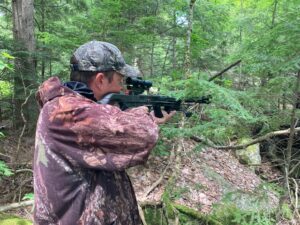Crossbows: The Purchase Decision

By V. Paul Reynolds
Recently passed, Maine has a new crossbow hunting law that, is not only sweeping in scope, but makes sense. Crossbows, the use of which has been very restrictive, are now included in the legal definition of archery equipment. This is a big deal! For it means that, in Maine, all hunters are allowed to use crossbows during all archery seasons. This change means that hunters of all ages can now use crossbows to hunt deer and other game during both the Expanded Archery Season in September and the regular archery only deer season in October.
Less Red Tape
Additionally, hunters do not need to take a separate course specifically for crossbows. An education program is required for an archery license, but this license includes conventional vertical bows and crossbows.
Crossbows used for hunting must include a draw weight between 100-200 pounds. Pistol type crossbows are prohibited and broad heads must be at least 7/8 inches wide.
If you are planning to purchase a crossbow, you are best advised to do your homework. There is a vast array of crossbows to choose from in terms of price and function. The different types of crossbows each have their own features and advantages. All crossbows are known for their power, accuracy and ease of use.
This review of the different types of crossbows should get you started. For big game hunting, there are three basic types, each with a different mechanical design. To learn more about crossbows and help you in your purchase decisions, we talked with Andrew Carr and Seth Legere at the Kittery Trading Post (KTP). Legere is KTP’s divisional manager for Shooting Sports. Carr is an assistant manager for the archery department. Here is some of what we learned from them:
1. RECURVE CROSSBOWS
These are known for their simple design and ease of maintenance. They are simple, reliable and easier to maintain. They also tend to be lighter and quieter.
2. COMPOUND CROSSBOWS
These bows use a system of pulleys and cams, which allows them to store more energy and deliver more power in a shorter draw length. They can be more compact and easier to handle in tight spaces. like, say a ground blind. Both versions have cocking aids, entry level and high end models.
.
3. REVERSE DRAW CROSSBOWS
These bows have limbs that, unlike a compound crossbow, face forward towards the shooter. This shifts the center of gravity closer to the shooter’s body. These devices can be more stable and balanced, and can have more speed due to a longer power stroke, which is the time in which the string has in contact with the bolt upon firing.
Legere says that Kittery Trading Post offers more than eight different brands of crossbows with a dozen or so different models within each brand. Prices run the gamut from about $200.00 all the way up to $2,500.00. Legere says, “ You can obtain a reliable compound crossbow, such as Killer Instinct for $300.00, Some of the brands of crossbows carried by the Kittery store are Excalibur, PSE, Bear, Wicked Ridge Raven, Killer Instinct, Mission, and Ten Point.
Carr says that among the three choices of crossbow types, the compound crossbow is the biggest seller.
According to Carr, there are two standard methods of cocking a crossbow. The most common is the rope method for cocking the bow. The other is the mechanical cranking device, which is available in some fashion for most crossbows.
As a rule, compound crossbows, which tend to have draw weights in the middle 100s, will send an arrow, or a so-called “bolt,” much faster than a conventional bow, sometimes in excess of 400 feet per second.
Popular Notion
Carr does not buy in to the popular notion that crossbows, unlike conventional bows, don’t require a lot of practice. “Good hunting ethics dictate that even crossbow hunters practice, and get to know their bow and their own individual shooting capabilities,” says Carr. “As a rule, crossbows, with their higher energies, can give a practiced shooter an option to take game at longer distances. But the increased speed of a crossbow is not enough to beat a spooked deer’s senses, resulting in a poor shot and wounded game. Similar ranges to that of a vertical bow are always best.”
Legere makes the point that smart crossbow buyers will give their decision a lot of careful thought and homework, just as though you were buying a hunting rifle. In order to make the wisest purchase, with so much to choose from, visiting a sporting good outlet is advised. In talking to an informed sales person, who can walk you through all the options, you need to consider the type of game you will be hunting, whether you will be in a ground blind or tree stand, and your own experience and physical strength.
Get Advice
With Maine’s new crossbow law, that now allows most any archer to hunt any archery season with the crossbow for the first time, sporting goods stores in Maine, like KTP, are expecting a lot of buyer interest in the possibility of buying a crossbow before the fall hunting season.
Finally, both Carr and Legere emphasize this point to anyone who purchases a crossbow: “It is imperative that all new crossbow owners follow the bow’s operation manual to the letter. The warranty is only good if buyer’s do so.” For example, if something goes wrong, even with a new crossbow, the warranty is only good if you adhere strictly to the manual such as the use of factory bolts as recommended by the particular manufacturer.
For more articles about hunting, fishing and the great outdoors, be sure to subscribe to the Northwoods Sporting Journal.
